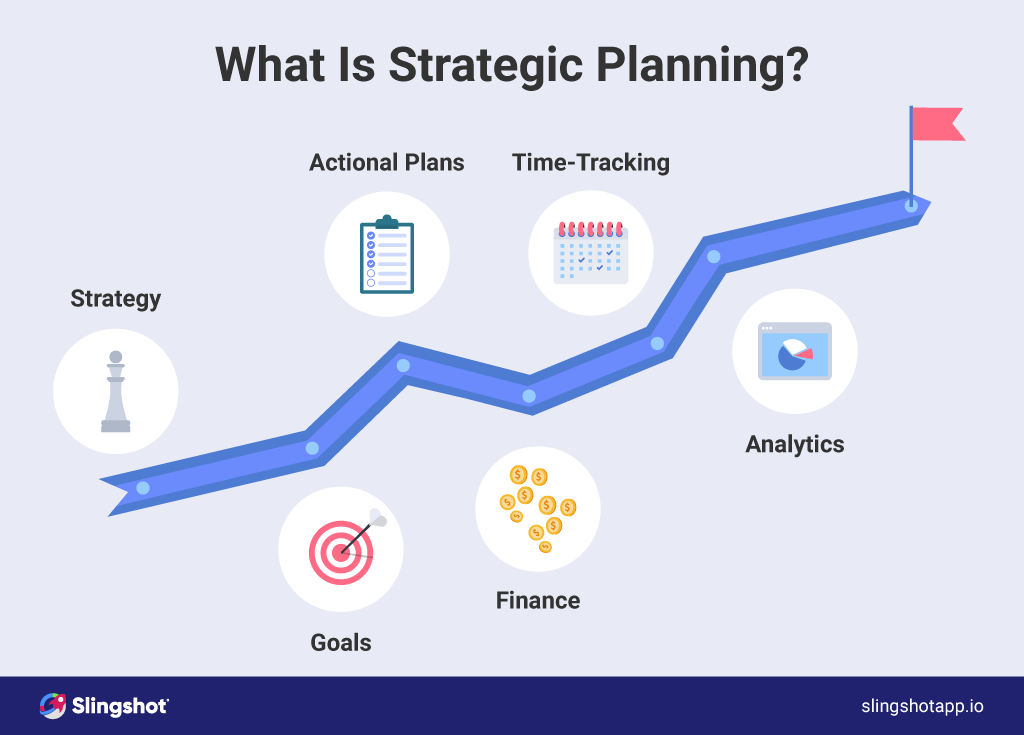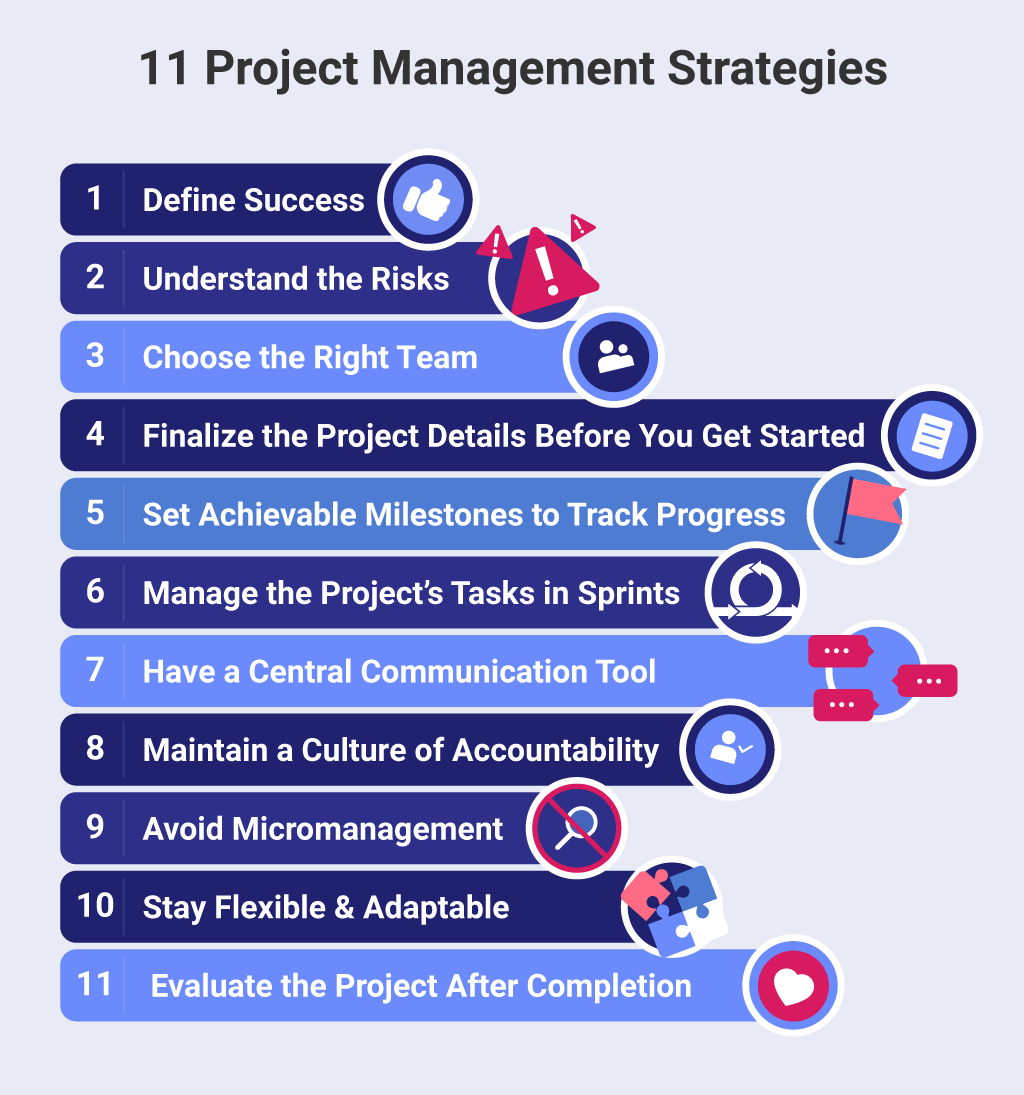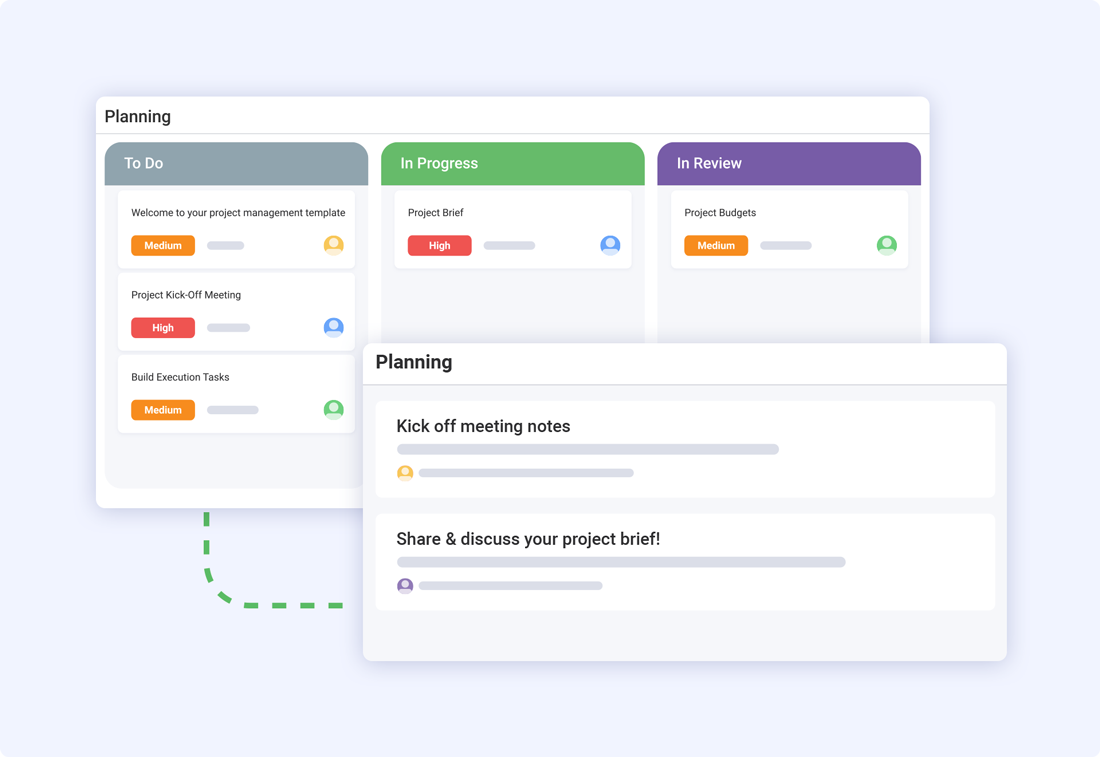
요약:
프로젝트 관리는 수많은 작업, 팀, 마감일을 저글링하는 것처럼 느껴질 수 있습니다. 최선의 노력을 기울여도 마감일을 놓치거나, 예산을 초과하거나, 기대치를 충족하지 못하는 등 프로젝트가 부족해지는 경우가 있습니다. 그러나 올바른 프로젝트 관리 전략을 수립하면 계획과 성공적인 실행 사이의 격차를 해소할 수 있습니다.
이 블로그에서는 프로젝트를 성공으로 이끄는 데 도움이 될 수 있는 11가지 실행 가능한 프로젝트 관리 전략을 안내합니다. 올바른 팀을 구성하는 것부터 책임감을 키우는 것까지, 이러한 전략을 즉시 실행에 옮겨 결과를 개선하고 프로젝트를 순조롭게 진행할 수 있습니다.
전략적 계획이란 무엇입니까?
전략적 계획은 장기적인 비즈니스 방향을 정의하고, 목표를 설정하고, 이를 달성하기 위해 실행 가능한 계획을 수립하는 프로세스입니다. 마케팅, 영업, 재무 등 여러 부서를 공통의 목표를 중심으로 통합하고 모든 리소스와 문서가 조정되도록 합니다.
프로젝트 관리에서 전략적 계획은 명확성을 제공하고 모든 팀원이 프로젝트의 목표, 타임라인 및 리소스 할당을 이해하도록 하는 데 매우 중요합니다.

프로젝트 관리 전략이란 무엇입니까?
프로젝트 관리 전략은 프로젝트 관리자가 팀을 성공적인 결과로 안내하기 위해 사용하는 방법과 프레임워크입니다. 그들은 모든 구성원이 목표, 작업 및 기대치를 이해하도록 하여 응집력 있고 생산적인 팀 역학을 육성합니다.
프로젝트 관리 전략을 사용하는 이유는 무엇입니까?
이러한 전략은 팀이 일관성, 생산성 및 민첩성을 유지하는 데 도움이 됩니다. 프로젝트 관리 전략을 구현함으로써 팀은 보다 효과적으로 문제를 해결하고, 진행 상황을 추적하고, 목표를 달성할 수 있습니다. 명확한 전략은 더 나은 의사 결정, 간소화된 워크플로, 궁극적으로 성공적인 프로젝트 납품을 가능하게 합니다.
11가지 프로젝트 관리 전략
프로젝트를 성공적으로 관리하고 실행하려면 단순히 좋은 아이디어 이상이 필요합니다. 다음의 11가지 프로젝트 관리 전략을 통해 모든 프로젝트를 처음부터 끝까지 완벽하게 관리할 수 있습니다.

1. 성공의 정의
마감일을 지키고 예산 범위 내에서 프로젝트를 진행하더라도 의도한 목표를 달성하지 못하면 프로젝트가 진정으로 성공할 수 없습니다. 프로젝트의 범위, 타임라인, 예산, 팀 만족도, 고객 만족도 및 품질 표준을 정의하여 처음부터 성공 기준을 설정합니다. 이러한 명확성은 프로젝트 전반에 걸쳐 팀을 안내하고 마지막에 성공 여부를 평가하는 데 도움이 됩니다.
2. 프로젝트의 성공에 영향을 미칠 수 있는 위험을 이해합니다.
모든 프로젝트에는 위험이 따릅니다. 초기에 위험 분석을 수행하여 잠재적 위협을 식별하고 비상 계획을 수립합니다. 사전 예방적 대응을 통해 위험을 효과적으로 관리하고 중단 가능성을 줄일 수 있습니다.
3. 올바른 팀 선택
올바른 팀을 선택하는 것은 프로젝트의 성공에 필수적입니다. 당면한 특정 프로젝트에 필요한 기술과 전문 지식을 기반으로 팀을 구성합니다. 팀의 능력을 프로젝트의 요구 사항에 맞게 조정하면 보다 원활한 실행을 위한 기반을 마련할 수 있습니다.
4. 시작하기 전에 프로젝트 세부 사항을 마무리하십시오.
프로젝트를 시작하기 전에 모든 계획, 역할 및 책임이 명확하게 정의되어 있는지 확인하세요. 이러한 세부 정보를 팀에 미리 제시하여 혼란을 최소화하고 세세한 관리의 필요성을 없애십시오. 모든 사람이 처음부터 자신에게 기대되는 것이 무엇인지 알고 있으면 실행이 더 간소화되고 효율적입니다.
5. 진행 상황을 추적하기 위해 달성 가능한 마일스톤 설정
프로젝트를 더 작고 측정 가능한 마일스톤으로 나누면 계획대로 진행할 수 있습니다. 정기적으로 마일스톤을 달성하면 팀에 동기를 부여하고 진행 상황을 명확하게 볼 수 있습니다. Slingshot의 사용자 정의 필드를 사용하면 이러한 이정표를 실시간으로 추적할 수 있으므로 프로젝트의 각 단계를 더 잘 제어할 수 있습니다.
6. 스프린트에서 작업 관리
애자일 접근 방식을 채택하여 프로젝트의 작업을 스프린트(특정 작업이 완료되는 짧고 정의된 기간)로 관리하세요. 이 타임박스 방식은 더 나은 시간 관리를 보장하고 팀이 달성 가능한 작은 작업에 집중할 수 있도록 하여 큰 진전을 이끌어냅니다. Slingshot의 작업 유형 기능은 이러한 스프린트를 반영하도록 사용자 정의하여 팀을 체계적으로 유지하고 보조를 맞출 수 있습니다.

7. 중앙 커뮤니케이션 도구를 가지고 명확한 커뮤니케이션을 구축하십시오.
효과적인 커뮤니케이션은 모든 성공적인 프로젝트의 핵심입니다. 중앙 커뮤니케이션 도구를 사용하면 대화, 피드백 및 아이디어가 계속 흐르도록 하는 데 도움이 됩니다. Slingshot 채팅, 파일 공유 및 작업 관리를 하나의 플랫폼으로 결합하여 팀이 원활하게 협업하고 문제를 신속하게 해결할 수 있습니다.
8. 책임감 있는 문화 유지
책임감은 성과를 이끄는 원동력입니다. 모든 팀원이 자신의 책임과 결과에 대해 주인의식을 가질 수 있는 문화를 조성합니다. 먼저 스스로 책임감을 발휘하여 결정을 내리고, 피드백에 개방적이며, 팀원들도 그렇게 하도록 격려하세요.
9. 세세한 관리를 피하십시오
세세한 관리는 창의성을 억누르고 스트레스를 증가시킨다. 모든 작업에 몰두하는 대신, 팀이 업무에 대한 주인의식을 가질 수 있도록 지원하세요. 그들이 제공할 것이라고 믿고 필요할 때만 개입하십시오.
10. 유연성과 적응력을 유지하십시오.
프로젝트 계획은 프로젝트가 진행됨에 따라 발전해야 합니다. 정기적으로 전략을 재평가하고 효과가 있는 것과 그렇지 않은 것에 따라 조정하여 적응력을 유지하세요. 유연성을 갖추면 문제에 신속하게 대응할 수 있어 프로젝트가 순조롭게 진행될 수 있습니다.
11. 완료 후 프로젝트 평가
아무리 잘 계획하고 실행하더라도 항상 개선의 여지가 있습니다. 각 프로젝트가 끝나면 시간을 내어 성공 여부를 평가하십시오. 무엇이 효과가 있었습니까? 그렇지 않은 것은 무엇입니까? 다음에 무엇을 개선할 수 있습니까? 이러한 인사이트를 사용하여 앞으로 나아가는 프로젝트 관리 전략을 구체화하세요.
성공적인 실행을 위해 프로젝트 관리 소프트웨어를 사용해야 합니까?
프로젝트 관리 소프트웨어는 프로젝트를 효율적으로 계획, 추적 및 실행하는 데 없어서는 안 될 필수 요소입니다. 모든 프로젝트 작업, 마감일 및 커뮤니케이션을 중앙 집중화하여 팀이 더 쉽게 협업하고 동일한 페이지를 유지할 수 있도록 합니다. 프로젝트 매니저는 올바른 도구를 사용하여 시작부터 완료까지 전체 프로젝트 라이프사이클을 간소화하는 동시에 마감일을 놓치거나 예산을 초과할 위험을 줄일 수 있습니다.
Slingshot 어떻게 성공적인 프로젝트 실행에 도움을 줄 수 있나요?
Slingshot 프로젝트 관리 전략을 한 단계 업그레이드하는 데 도움이 되도록 설계되었습니다. 여러 팀을 관리하거나, 복잡한 타임라인을 추적하거나, 더 나은 커뮤니케이션을 촉진해야 하는 경우, Slingshot 성공을 이루는 데 필요한 도구를 제공합니다.
맞춤형 추적을 위한 사용자 정의 필드, 워크플로 사용자 정의를 위한 작업 유형, 기본 제공 분석과 같은 기능을 갖춘 Slingshot 프로젝트를 실시간으로 쉽게 관리할 수 있도록 합니다. 작업 관리, 커뮤니케이션, 데이터 분석을 하나의 플랫폼에 통합함으로써 Slingshot 사일로를 제거하고 팀이 보다 효과적으로 협업할 수 있도록 지원합니다.
Slingshot 어떻게 당신의 팀이 놀라운 성과를 낼 수 있도록 도울 수 있는지 보실 준비가 되셨나요? 오늘 무료로 사용해 보시고 차이점을 경험해 보세요.

관련 기사
AI 의사 결정을 통해 비즈니스를 10배 성장시킬 준비가 되셨나요?
무료 데모 요청 Slingshot이 게시물 공유하기







